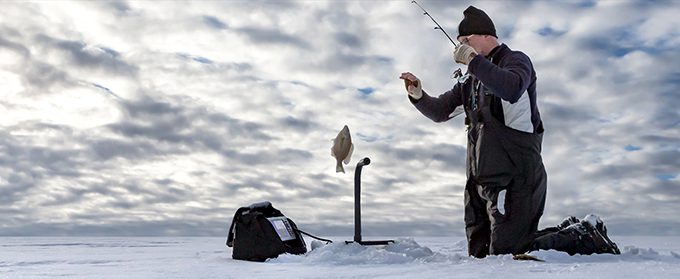Sponsored by Garmin
If there were ever a time for the saying “I remember back in the day…”, this article would definitely be a prime candidate. We’re not sure how old you are, but we here at Fish’n Canada (Ang and Pete anyways…) have certainly been around and could use that saying time and time again.
Ice fishing is one of those sports in which technology has advanced but, since the popularity of ice fishing pales in comparison to open water fishing, many people simply never hear of the technological forward pace that is happening.
From Past to Present
Travelling across the ice can be such a daunting and often exhausting adventure. Snowmobiles have been around for a long time, but 30-plus years ago, they were more of a luxury, take-it-for-a-spin vehicle and not as much for work like ice fishing (although savvy anglers did have a head start on this one).
ATVs were mostly the 3-wheeled variety that, as we know now, were some of the most unsafe vehicles ever created. Not great for on-ice activities.
Believe it or not, the most popular vehicles for ice fishing were cars and trucks. Once the ice hits a safe level (usually), ice anglers drove out, with heaters blasting, in true comfort. But those were occasional travel modes. Normal ice travel essentially was putting your gear on a light sled and trekking on foot for whatever time it took to get to the fishing hole.
Nowadays, snowmobiles, and especially ATVs, are commonplace on the ice.
Rods and reels have also come a long way. The old days had anglers often setting up “gads” which were small, flexible twigs or branches in which you tied your fishing line to and waited until it got yanked towards the hole.
Now there are ice rods, reels, and combos running well into the hundreds of dollars range!
Same goes for lures, line, augers, etc. Everything has advanced.
Which brings us to this article’s intent. Ice fishing electronics.
Modern Day Ice Electronics
Garmin has been tirelessly working with ice anglers to come up with some of the best and most user-friendly, dedicated ice fishing fishfinders on the market. And we feel they’ve succeeded.
This technology now poses a question: why use a fishfinder/chartplotter for ice fishing?
Our quick answer to that is “why not”?
Looking back to the first statement in this article of remembering back in the day, Pete and Ang remember when there was no such thing as ice fishing fishfinder.
Chartplotters
“Things were so random when I first started ice fishing,” says Ang, “we’d walk out an ungodly distance in a snowstorm, look around and say ok, it looks good here, and start drilling holes. If we caught fish, it would be perfect but so many times we didn’t”.
Those long, aimless walks would usually include a slip and fall if there was no snow and the surface was bare, or a pair of boots collecting slush – making them ridiculously heavy!
Today, with the aid of a Chartplotter (GPS unit), anglers can pre-designate fishing spots on a contour map and head straight out to their possible hotspot. Better yet, if anglers have existing waypoints or are given some by successful angling friends, they can be drilling holes dead-on the money!
Fishfinders
“So, after those long, exhausting walks that Ang just mentioned above,” says Pete, “we’d manually drill or spud our holes and then sit there ALL DAY LONG, waiting for something to happen. We’d usually end up staring at the hole, jigging away, and occasionally looking over at our second line (which was in the same location all day as well). It was so boring and very much an unproductive way to try and contact fish. Many days were essentially just wetting a line”.
With the aid of a fishfinder, now things get interesting.
First off, simply having something to look at is 100% more fun than staring at nothing.
Second, seeing structure and cover is extremely helpful. Setting up on the outside tip of a weed point, for instance, tells you that you’re in a prime location.
Third, seeing baitfish in and around your fishing area is massive.
Fourth is, of course, seeing fish. By seeing your quarry, you now have the confidence that fish are around you and the possibility of hooking up is high.
Finally, seeing your lure or presentation is crucial in possibly making contact with a fish. Raising or lowering your bait and “teasing” a fish (see below), all while watching in real-time, is such an effective way of putting fish on the ice!
Units We Recommend
As we said, Garmin has taken a giant step into the ice fishing world. Here are some of our recommendations.
The Striker Plus 4 Ice Bundle is a great entry-level ice unit that will get the job done. It comes in at a great price point and has lots of features (see link) for a day on the ice.
The Striker Vivid 5cv Ice Fishing Bundle is a step up from the 4-Plus in having a larger screen, a high-wide traditional chirp transducer, the Vivid colour scheme screens and is great to convert to an open water unit when adding the optional all-season feature adding the GT20-TM transducer.
The EchoMap UHD 63cv Ice Fishing Bundle. Now we are getting into the EchoMap family of fishfinder/chartplotters. This, again, is a step up from the Striker series. We absolutely love our EchoMaps, they are workhorses.
And finally, the Panoptix LiveScope Ice Fishing Bundle. When all the stars align as an angler and you can obtain the best of the best, this is the baby for you. It does all of the above, however, it gives you the ability to scan in a live view forward, downward and, if the conditions allow, even in an overhead, aerial style, perspective view. Viewing underneath your hole in the ice is such a huge advantage when ice fishing.
With the addition of a traditional ice transducer, you can also go old-school (we say that jokingly because of the advancement of this unit) in the flasher or the traditional viewing/A Scope modes. That said, once you try LiveScope, you probably won’t use much else.
This unit also seconds as an awesome open-water setup. Throw in a UHD transducer and you’re off and boating!
To win this fishfinder, see the link below to enter our latest contest and check back in daily for new ways to win!
Some Reasons Why: Chasing Lakers For One…
One of the most interesting, satisfying, and frustrating aspects of using a fishfinder while ice fishing is when Lake Trout fishing. Nowhere is a fishfinder more revealing than this.
The Lake Trout is a funny creature. One uniquely “weird” aspect is their uncanny need to chase bait. We found this many years ago while fishing on Selwyn Lake in Saskatchewan. Our guide asked us if we wanted to take a break from trolling for Lakers and sit on a school of fish that he vertically jigs for.
“Hell yeah!” we said.
“I vividly remember this scenario,” says Pete, “I was in a boat with Reno Viola and the lodge guide. Ang and the cameraman were in another. We arrived at the school of fish and started jigging”.
“Reno and I let our spoons/jigs down and in typical Lake Trout jigging fashion, kept them down and working close to the bottom. The guide, however, dropped his gigantic bucktail jig down pummelling it into the bottom, pumped it a few times, and then reeled it in as fast as he could. We wondered what was wrong, was the bait tangled or something? But as he got it close to the surface, he simply dropped it to the bottom again and repeated the procedure”.
“Reno and I looked at each other like this guy was on crack… like WTH????”
“Well, on about the 3rd or 4th ripping-reel-up… smash, a gorgeous aggressive Laker pounded his offering. This happened again and again until Reno and I jumped on the bandwagon.”
This single trip proved to Pete and Reno and Ang that Lake Trout, more than any other freshwater fish (including Muskie) were stalkers and chasers. A huge fishing lesson!
This scenario is exactly why, if you want to be successful at ice fishing for Lakers, you NEED a fishfinder.
In flasher, traditional with the A Scope, or live view modes, you can literally see your bait and the Laker in this cat-and-mouse game. It very often converts to a caught fish.
NOTE: Be prepared to be as frustrated as you’ve ever been on a fishing excursion since many times, inquisitive Lake Trout simply want to follow but don’t want to eat.
Dead or Alive
Another situation in which using a fishfinder is at least much more entertaining, is when fishing dead baits for Northern Pike. To see that predator move in onto your screen, then roam around, sniffing and prowling, trying to figure things out, and then finally taking your bait… it’s amazing and exciting to watch.
Teasing
The most common use of a fishfinder when ice fishing is on those fish that show some interest but don’t want to commit. A good ice angler can entice that fish by predicting, and through experience, knowing its every move while reacting to a bait. So often anglers can slightly lift up their presentation, maybe shake it a bit (sometimes that’s a negative by the way, but you’ll see that on the fishfinder) and totally tantalize and tease that fish into biting.
It’s an absolute blast!
Conclusion
As you can probably tell, we feel that fishfinders are an absolute must on the hard water. We use them constantly while on open water so it makes sense to move that same technology onto the ice.
Give it a try, once you experience a fish or two on your screen, we believe you’ll be hooked.






3 Responses
Enjoyed reading this story about ice fishing with sonar. Up till now I’ve been walking on the ice in my floater suit ( tested and proven thru the ice in front of Parry Sound) to get to the fishing holes dragging my overflowing Smitty sled. A snowmachine or ATV would be nice but hard to find in this Covid climate. I’m looking forward to using my new Garmin Livescope replacing my old Humminbird sonar that must be 15 years old now. All my buddies will be following me like lemmings after the pied piper LOL. A couple of them still fish without a finder . I wouldn’t be without one. It’s much more enjoyable and exciting to see those trout chase and nail my lure. We hope the Big Sound will freeze this year other wise we’ll stick to the inland lakes. Thanks for the great entertainment and educational information that your web site and TV show provides to us anglers. Happy New Year from Parry Sound !
My son loves fishing, but lately video games are competing. Thanks for the tip, I’m definitely going to try getting a fish finder
I never thought of gear like this for ice fishing